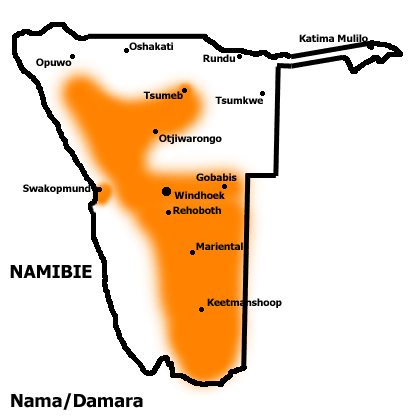|
|
Introduction
The Damara are an ethnic group of central and southern Namibia, they are divided into different tribes.
Among 80 000, they represented 8.2% of Namibia's population at the end of the twentieth century.
Geographical distribution of Damara:

History
Their origin is still unknown.
According to anthropologists, treated as Khoisan people, these may be the first Bantu group (originally from central Africa) came to be settled in Namibia to the ninth or tenth century.
The Damara occupied the center of Namibia, but were repulsed by the successive waves of migration and warlike people from the south such as the Nama and Oorlams the 1820s, but also by those from the north as the Herero who reduced them in slavery.
Freed from their bondage to the late nineteenth century by the German colonial administration, the Damara have long been assigned to their ancestral territories called Damaraland.
These territories were established administratively into Bantustan under apartheid when South Africa led the South-West Africa (now Namibia).
It was founded in 1970 as Damaraland and geographically bounded by the Odendaal Report.
This territory had 44,000 inhabitants and the capital was Khorixas (11 000 inhabitants).
Damaraland was incorporated in 1992 in the new post-apartheid Kunene region.
Lifestyle and Culture
Although Bantu type, the Damara language speakers to "clicks".
They are among the oldest inhabitants of Namibia.
Only a quarter Them still live poor land of Damaraland in north-west, others to work on commercial farms, mines, or as laborers in cities.
A significant number of Damara found refuge in the mountains ( Brandberg ) or in sparsely populated regions (near Otavi mountains or hills of the Khomas Hochland) to escape persecution of aus Nama, which in turn, refused the wild lifestyle Damara of hunter-gatherers.
|
|



